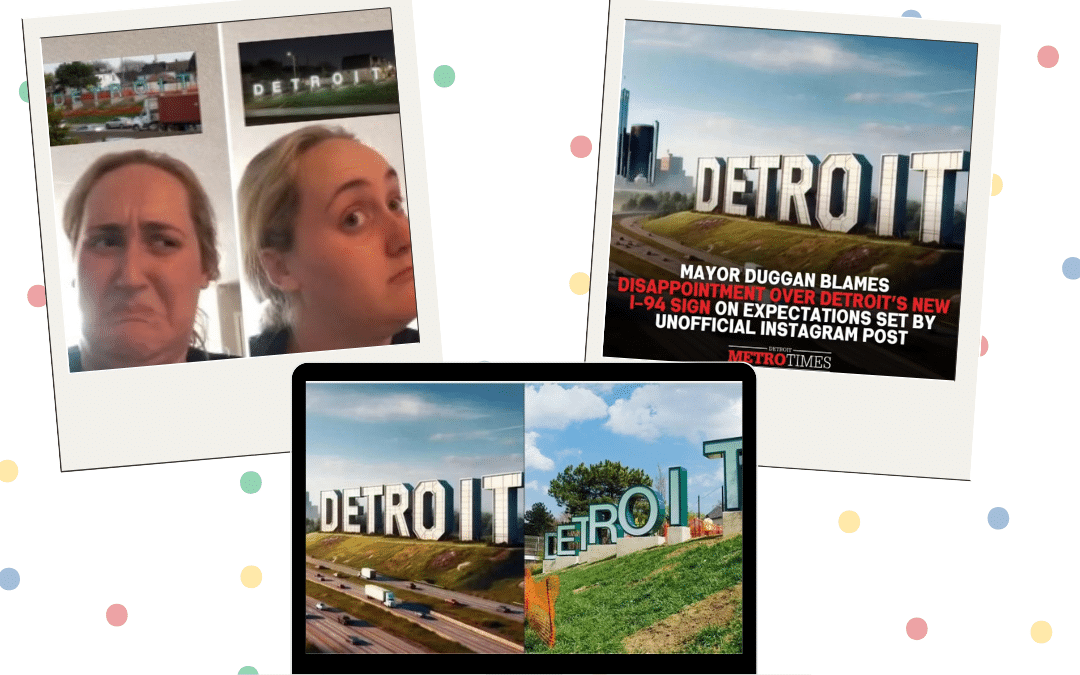The unveiling of Detroit’s 8-foot-tall, $300,000 “Detroit” sign along I-94 was met with public disappointment, as initial expectations of a grand, Hollywood-style structure gave way to a more modest reality. Despite falling short of the online renderings, the sign symbolizes the city’s revitalization efforts and marks a significant milestone in showcasing Detroit’s ongoing transformation.
As the city prepared for the NFL draft, officials aimed to create an eye-catching gateway for visitors. However, the initial backlash highlights the importance of transparent communication and narrative control. Had details like the sign’s dimensions, budget, and design been shared earlier, public reception may have been more positive.
The disconnect stemmed from a lack of clear communication from the city throughout the planning process. With few official details provided, an AI-generated image of a massive, iconic “Detroit” sign circulated online, fueling unrealistic expectations. When the sign was finally unveiled, critics lamented its underwhelming appearance and missed opportunity to incorporate local icons like the “Old English D” font. The sign’s Renaissance font and green-blue color scheme, inspired by Detroit and Windsor’s flags and logos, drew further criticism.
In an attempt to regain control of the narrative, the city released official renderings of the sign just two months before its installation along I-94. However, this effort proved too little, too late in reshaping public perception. Ultimately, the experience serves as a lesson in the importance of clear communication and setting accurate expectations when implementing public projects that aim to celebrate Detroit’s resilience and rebirth.
As public criticism mounted, Mayor Duggan’s dismissal of the viral AI rendering as “entirely fake” seemed to overlook the underlying issue: the city’s failure to proactively share accurate visuals. This approach not only left residents in the dark but also fueled the need for them to conceptualize their own versions. Had the city provided clear information from the start, the public would have had more time to process and come to terms with the sign’s design, potentially mitigating feelings of disappointment and shock upon its reveal.
Despite the controversy, city officials maintain that the design, combining elements of Detroit and Windsor’s flags, symbolizes shared pride and offers a warm welcome to NFL draft visitors. In the context of Detroit’s rebirth after decades of hardship, this sign, alongside broader beautification efforts, holds significance as a symbol of the city’s resilience and renaissance.
The saga highlights the importance of transparent communication in marketing when implementing significant changes. By neglecting to share key details early on, Detroit inadvertently relinquished control of the narrative, allowing public perception to be shaped by speculation and unrealistic expectations. This experience serves as a valuable lesson in the need for proactive, clear communication to manage expectations and foster public support for projects meant to celebrate and elevate Detroit’s inspiring revival story.
The property management industry can learn valuable lessons from Detroit’s experience with its new “Detroit” sign, particularly regarding the importance of transparent communication in managing expectations and maintaining a positive reputation. Just as the city’s mishandling of the sign’s narrative led to public disappointment and criticism, property management companies often make similar missteps by failing to provide clear information about renovation updates, construction timelines, or navigational signage.
At Smart, I’ve witnessed numerous missed opportunities to effectively communicate changes and manage customer expectations. In one instance, a community’s clubhouse was being renovated, and the leasing team operated out of a vacant apartment. Despite some directional signs, the office remained difficult to find. Situations like these can lead to frustrated customers who may share their negative experiences with others.
In another example, a colleague attempting to drop off a gift at a new construction site struggled to find the leasing trailer, as it was located at the back of the property without any directional signs or renderings. This missed opportunity to engage and inform potential customers could have been avoided with better communication and marketing efforts.
To build trust and encourage buy-in from customers, property management companies should prioritize transparency and proactively share information such as budgets, behind-the-scenes looks, and visuals that paint an accurate picture of what to expect. By involving customers as vested stakeholders in the process, they’ll be more likely to champion and celebrate outcomes rather than focus on misinformed preconceptions.
Detroit’s experience serves as a reminder that failing to control the narrative can lead to unnecessary challenges. Had the city shared crucial details like the sign’s dimensions, budget, and design elements early on, public reception may have been more positive. Ultimately, open and proactive communication not only sets realistic expectations but also fosters excitement and support for the final result.







